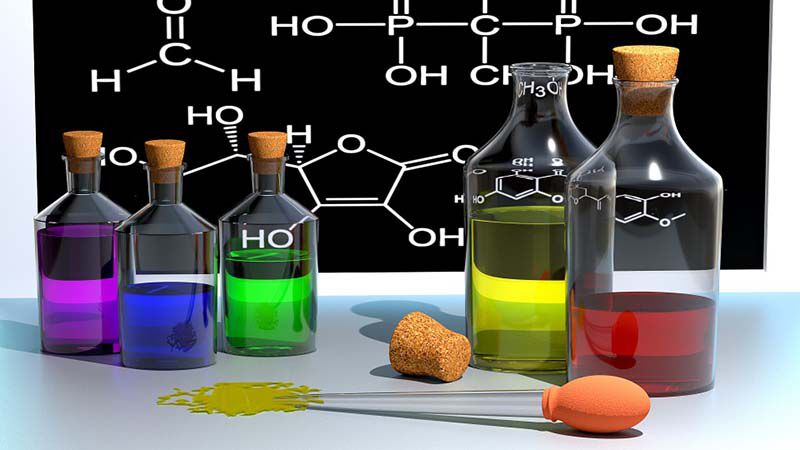ITT – Chemistry is a natural science subject which is highly practically applicable. It is also a branch of other sciences. Chemistry in English has been brought into teaching in Vietnam curriculum. It is aimed to support students in gaining more in-depth knowledge of this scientific subject thoroughly. Learners need to master several popular Chemistry terms in English.
Chemistry is applied in many aspects of life. Moreover, it is also one of the primary subjects for those whose major is Natural Sciences, especially for students with future career orientation is Doctor, Food Technology, Chemistry Engineer, etc. , a serious investment in Chemistry and Chemistry terms in English is extremely important.

Studying Chemistry in English is, according to several learners, complicated in terms of vocabularies and the chemical equation that needs memorizing. Below is the table of popular Chemistry terms in English students need to learn by heart when studying this subject.
| A | |
| 1. Acid (n) | A substance with particular properties including turning litmus red, neutralizing alkalis, and dissolving some metals. |
| 2. Acidic (a) | Having the properties of an acid
or containing acid or having a pH below 7.
|
| 3. Addition polymerization reaction (n) | A reaction in which many monomers bond together via rearrangement of bonds without the loss of any atom or molecule under specific condition of heat, pressure, catalyst. |
| 4. Addition reaction (n) | An organic reaction in which 2 or more molecules to form a larger one. |
| 5. Alcohol (n) | Any organic compound whose molecule contains one or more hydroxyl groups (-OH) attached to a carbon atom. |
| 6. Alkali (n) | A compound with chemical properties including turning litmus blue and neutralizing or effervescing with acids. |
| 7. Alkaline (a) | Having the properties of Alkali. |
| 8. Alkane (n) | Ankan CNH2N+1. |
| 9. Alkene (n) | Anken CNH2N. |
| 10. Anion (n) | A negatively charged ion. |
| 11. Anode (n) | The positively charged electrode by which the electrons leave an electrical device. |
| 12. Atmosphere (n) | A unit of pressure equal to mean atmospheric pressure at sea level. |
| 13. Atom (n) | The smallest particle of a chemical element that can exist. |
| 14. Atomic number | The number of protons in the nucleus of an atom, which is characteristic of a chemical element and determines its place in the periodic table. |
| B | |
| 15. Base (n) | A substance capable of reacting with an acid to form a salt and water. |
| 16. Boiling point (n) | The temperature at which a liquid boils and turns to vapour. |
| C | |
| 17. Catalyst (n) | A substance that increases the rate of a chemical reaction without itself undergoing any permanent chemical change. |
| 18. Cathode (n) | The negatively charged electrode by which electrons enter an electrical device. |
| 19. Cation (n) | A positivel charged ion, i.e. one that would be attracted to the cathode in electrolysis. |
| 20. Charge (n) | |
| 21. Chemical change (n) | Changes relating to chemistry or the interactions of substances. |
| 22. Chemical equation (n) | |
| 23. Compound (n) | A substance formed from 2 or more elements chemically united in fixed proportions. |
| 24. Concentration (n) | The relative amount of a particular substance contained within a solution or mixture or in a particular volume of space. |
| 25. Condensation (n) | Water which collects as droplets on a cold surfac when humid air is in contact with it. |
| 26. Condensation polymerization (n) | Any kind of polymers formed through a condensation reaction – where molecules join together – losing small molecules as by-products (water/methanol). |
| D | |
| 27. Density (n) | The quantity of mass per unit volume of a substance. |
| 28. Displacement reaction (n) | A chemical reaction in which a more reactive element displaces a less reactive element from its compound. |
| 29. Dissociation (n) | The splitting of a molecule into smaller molecules, atoms, or ions, especially by a reversible process. |
| 30. Double bond (n) | A chemical bond in which 2 pairs of electrons are shared between 2 atoms. |
| E | |
| 31. Element (n) | Each of more than one hundred substances that cannot be chemically interconverted or broken down into simple substances and are primary constituents of matter. |
| 32. Empirical formula (n) | A formula giving the proportions of the elements present in a compound but not the actual numbers or arrangement of atoms. |
| 33. Equilibrium (n) | A state in which a process and its reverse are occurring at equal rates so that no overall change is taking place. |
| 34. Exothermic reaction (n) | Reaction accompanied by the release of heat. |
| 35. Exponentiation (n) | The operation of raising one quantity to the power of another. |
| 36. Fermentation (n) | The chemical breakdown of a substance by bacteria, yeasts, or other microorganisms, typically involving effervescence and the giving off of heat. |
| 37. Fuel (n) | Material such as coal, gas, or oil that is burned to produce heat or power. |
| 38. Functional group (n) | A group of atoms responsible for the characteristic reactions of a particular compound. |
| H | |
| 39. Hydrogen bonding (n) | |
| 40. Hydrogenation (n) | Charge with or cause to combine with hydrogen. |
| 41. Hydrolysis (n) | The chemical breakdown of a compound due to reaction with water. |
| I | |
| 42. Immiscible liquids (n) | Liquids that are not forming a homogeneous mixture when mixed. |
| 43. Ionic bond (n) | |
| 44. Ionization energy (n) | Energy associated with ionization. |
| 45. Ionize (v) | Convert (an atom, molecule, or substance) into an ion or ions, typically by removing one or more electrons. |
| 46. Isomer (n) | Each of two or more compounds with the same formula but a different arrangement of atoms in the molecule and different properties. |
| 47. Isotope (n) | Each of two or more forms of the same element that contain equal numbers of protons but different numbers of neutrons in their nuclei. |
| L | |
| 48. Litmus paper (n) | Paper stained with litmus which is used to indicate the acidity or alkalinity of a substance. |
| M | |
| 49. Molarity (n) | The number of moles of solute (the material dissolved) per liter of solution. Used to express the concentration of a solution. |
| 50. Molar (a) | The amount of a chemical substance that contains as many elementary entities, e.g., atoms, molecules, ions, electrons, or photons, as there are atoms in 12 grams of carbon-12 (12C), the isotope of carbon with relative atomic mass 12 by definition. |
| 51. Mole (n) | Mole. |
| 52. Mole fraction (n) | |
| 53. Molecular formula (n) | A formula giving the number of atoms of each of the elements present in one molecule of a specific compound. |
| 54. Molecular weight (n) | The ratio of the average mass of one molecule of an element or compound to one twelfth of the mass of an atom of carbon-12. |
| 55. Molecule (n) | A group of atoms bonded together, representing the smallest fundamental unit of a chemical compound that can take part in a chemical reaction. |
| N | |
| 56. Neutral (a) | Neither acid nor alkaline; having a pH of about 7. |
| O | |
| 57. Oxidation (n) | The process or result of oxidizing or being oxidized. |
| 58. Oxidation number (n) | A number assigned to an element in chemical combination which represents the number of electrons lost (or gained, if the number is negative), by an atom of that element in the compound. |
| 59. Oxidation reaction (n) | Reaction leading to the result of oxidizing or being oxidized. |
| 60. Oxidation-reduction-reaction (n) | A type of chemical reaction that involves a transfer of electrons between two species. |
| 61. Oxidizing agent (n) | A substance that has the ability to oxidize other substances (cause them to lose electrons). |
| P | |
| 62. Periodic table (n) | A table of the chemical elements arranged in order of atomic number, usually in rows, so that elements with similar atomic structure (and hence similar chemical properties) appear in vertical columns. |
| 63. Pi bond (n) | A bond formed by a pi-orbital. |
| 64. Polar molecule (n) | A group of atoms bonded together, representing the smallest fundamental unit of a chemical compound that can take part in a chemical reaction. |
| 65. Potential energy (n) | The energy possessed by a body by virtue of its position relative to others, stresses within itself, electric charge, and other factors. |
| 66. Precipitate (v) | Cause (a substance) to be deposited in solid form from a solution. |
| Q | |
| 67. Quantum number (n) | A number which occurs in the theoretical expression for the value of some quantized property of a subatomic particle, atom, or molecule and can only have certain integral or half-integral values. |
| 68. Ratio (n) | The quantitative relation between two amounts showing the number of times one value contains or is contained within the other. |
| 69. Reactant (n) | A substance that takes part in and undergoes change during a reaction. |
| 70. Reactivity series (n) | An empirical, calculated, and structurally analytical progression of a series of metals, arranged by their “reactivity” from highest to lowest. |
| 71. Reducing agent (n) | An element (such as calcium) or compound that loses (or donates) an electron to another chemical species in a redox chemical reaction. |
| 72. Reduction (n) | A chemical reaction in which the oxidation states of atoms are changed. |
| 73. Reduction reaction (n) | A chemical reaction in which the oxidation states of atoms are changed. |
| S | |
| 74. Salt (n) | An ionic compound that results from the neutralization reaction of an acid and a base. |
| 75. Single bond | A chemical bond between two atoms involving two valence electrons. |
| 76. Solute (n) | A substance dissolved in another substance, known as a solvent. |
| 77. Solution (n) | A homogeneous mixture composed of two or more substances. |
| 78. Solvent (n) | Stated in “solute” section. |
| 79. Stp (n) | Standard temperature and pressure. |
| 80. Structural isomer (n) | A form of isomerism in which molecules with the same molecular formula have bonded together in different orders. |
Now, Intertu Education is enrolling potential students for Chemistry courses and Chemistry international programs (IB Chemistry, AP Chemistry, A-level Chemistry, IGCSE Chemistry). For inquiries, please contactus directly or via email or hotline.
Intertu Education

 Tiếng Việt
Tiếng Việt


